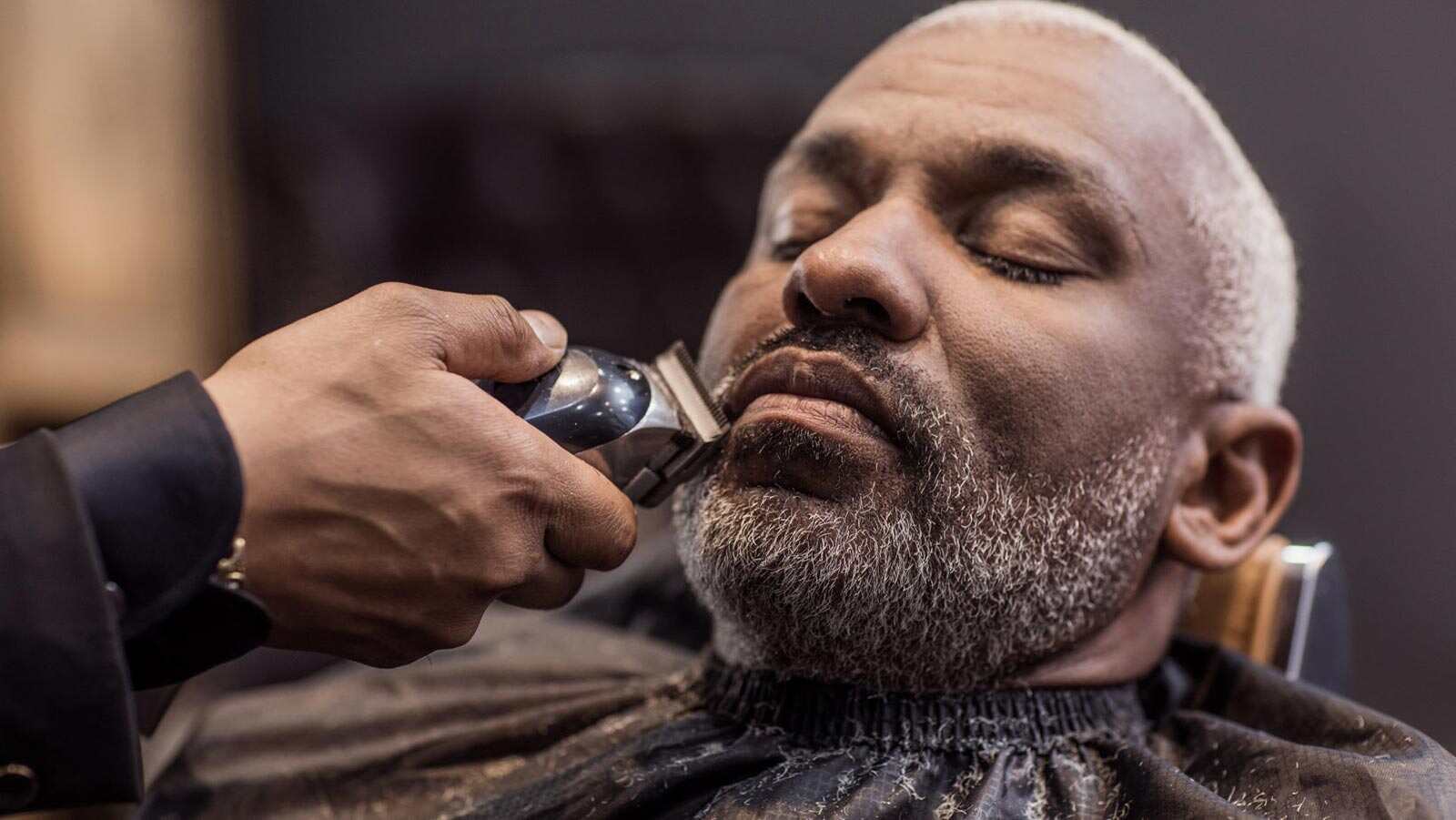The problem with ingrown hairs is they can lead to infection and cause permanent scarring if left untreated. Therefore, overcoming ingrown hairs is crucial to address before it causes skin issues.
Once the hair gets trapped, it can be challenging to remove the hair without causing damage to the skin.
Both men and women feel the frustration with pseudofolliculitis, but black men face the worst trouble preventing painful bumps due to unruly facial hair.
Learning about the hair growth cycle can help prevent pseudofolliculitis.
The Cycle of Hair Growth
When hair grows, it exits the skin through a shaft, but it resides in the dermal layer and extends from the epidermis, where the follicle and pore are the same. When the pore becomes clogged, the hairs become trapped, blocking the opening for the hairs to exit. We need to look more into the follicle to understand the hair growth cycle.
The follicle is grouped into "follicular units," each containing an average of 2-4 hairs per unit. The number of hairs per unit can vary among individuals and body regions, but men and women have a growth cycle that undergoes three (3) phases. The first phase lasts 2-7 years, transitioning from the growing phase to the resting phase, which lasts about two weeks in the second phase. The hair sheds or falls out of the follicle during the final phase.
Men's hair is usually fuller and thicker than women's on their faces, legs, and armpits, making them more prone to ingrown hairs. However, women may experience ingrown hairs after shaving or waxing in the groin areas, specifically the bikini area. The complexity of facial hair texture and hair growth patterns contributes to the start of the battle against ingrown hairs.
Why Shaving Too Much Is Bad For Black Men?
For black men shaving too much is bad for your skin. It increases the chances of getting ingrown hairs and causes "facial masking," a skin discoloration from shaving that darkens a large area of the skin.
Men that shave more than twice a week will start seeing this darkening of the skin happening where more hair follicles are present. The more you shave, the area is outlined as darker with resembles a mask. Once the skin is discolored, treatments are recommended, such as depigmentation masks or laser treatments.
Hair Texture vs. Hair Pattern
Irregular hair growth patterns can cause ingrown hairs when hair grows in different directions and at varying stages. Hair texture and pattern play a significant role in managing pseudofolliculitis barbae. Black men have a more challenging time with this problem because their hair is denser, making it tough to identify the hair pattern and difficult to tame before shaving as the hair appears stiffer, which is harder to train.

Compared to white men and women, black men's hair is considerably more coarse, resulting in larger follicles that produce more hair strands in a single "follicular unit." Successfully addressing coiled, curly, or wavy facial hair is tedious. Curly hair is less kinky and more manageable than coiled hair, but it is still challenging to prevent hairs from growing back into the skin compared to wavy hair. Straight hair is less likely to cause ingrown hairs than coiled or curly hair. Nevertheless, it's not impossible to find the hair growth pattern, and here are some tips to help discover it:
1. Wash the area you wish to address.
2. Leave the skin slightly damp.
3. Gently move your hands back and forth.
After you’ve cleaned the hairs and touched the texture, begin to brush the hairs downward, then upward. You should notice some hairs sticking up. Look closely at the direction the hairs are pointed, and rub your fingers gently across the hair. In the opposite direction, locate angles. From here, you should be able to determine the advice for your hair pattern. However, this process takes some time to pinpoint each section of the area. In most cases, the facial hair on the cheek and jaw will grow toward the mouth or the direction of the ears; however, the neck area may have at least 2-3 hair growth patterns. Therefore shaving in one order on the neck can cause ingrown hairs instantly.
Identifying Psedudofolliclitis
Pseudofolliculitis, even though it may not be as severe as folliculitis, should be treated seriously as it can result in permanent skin damage. It is essential to be aware of the three types of ingrown hairs.
- Hair that grows out and curls back into the skin: This type of ingrown hair occurs when the hair shaft exits the follicle but reenters the skin, causing irritation and inflammation. It happens more often when the hair is cut or shaved too closely, creating a sharp edge that can easily pierce the skin again.
- Hair that grows underneath the skin: The hair follicle does not exit the skin’s surface; instead grows parallel to the skin, trapped beneath it. More common for black men with curly or coarse hair.
- Hair trapped due to clogged pores and blocked follicles occurs when dead skin cells and oil block the hair follicle’s opening, preventing the hair from growing naturally. The hair is trapped under the skin’s surface, leading to ingrown hairs.

Enduring either of the three types of ingrown hairs is painful, in which you may want to remove the trapped hair immediately. Sometimes, you might be prompted to do it yourself because the pain is unbearable. However, I must advise you to avoid squeezing or puncturing the skin in the affected area as it can worsen, causing the folliculitis to spread or hyperpigmentation to occur.
Folliculitis: Is inflammation of more than one hair follicle that is inflamed and infected caused by bacteria resulting from ingrown hairs.
Hyperpigmentation: Dark markings or spots on the face or body. Post-inflammatory occurs after inflammation has occurred, such as folliculitis or acne. The skin produces more melanin after it has been injured or infected.
The Difference Between Hair Follicles and Pores
There's no difference between"hair follicles" and "pores," often used interchangeably. In reality, each pore on the skin is the opening to a hair follicle where the hair shaft emerges.
Over time, excess oils and dead skin cells can clog the hair follicle, leading to an enlarged pore. Unfortunately, men with kinky and wiry facial hair are more prone to enlarged pores due to the larger diameter of their hair than those with finer facial hair.
Overcoming Ingrown Hairs
Dealing with ingrown hairs is a common problem that affects many people. It's essential to address the root cause to find a solution. If you want to prevent ingrown hairs, you can follow the tips below:
- Exfoliate: Exfoliating helps remove dead skin cells and unclogs hair follicles allowing the hairs to grow out quickly.
- Tame & Train Hair
- Avoid Continuous Friction: Continuous friction can irritate the skin and increase ingrown hairs. After a fresh shave, never put on clothing that can rub against new shaved skin. Avoiding high-collar shirts for a day or two is recommended.
- Warm | Cool Compress: applying warm compresses to affected areas can help reduce inflammation and open up the pores allowing trapped hairs to emerge. Cool compresses are great to use after shaving to close the pores to prevent skin irritation and sensitivity.
- Essential Oil: Essential oils have anti-inflammatory, anti-microbial, anti-fungal, and anti-viral properties to heal the skin effectively. Tea Tree is the most effective oil to treat ingrown hairs. Other oils to try are lemongrass and lavender to heal the skin.
- Use Single-Blade Razors: Using a single-blade razor is highly recommended. Instead, it’s visiting your barber for a hot shave with a straight razor or DIY with a razor that suits your style, keeping you well-groomed and lowering the risk of ingrown hairs.
- Professional Help from a licensed skin expert: This can help you extract the ingrown hair without causing damage to your skin. A dermatologist or esthetician can offer additional services to help with preventive options and reduce ingrown hairs.
- Topical Treatments: Glycolic, Salicylic, and Chemical exfoliates are great for instantly removing dead skin cells and loosening up dead skin and trapped hairs
- Laser Hair Removal: This is a severe treatment. I recommended getting a highly trained specialist dealing with melanin skin. New technology has been improved to complement darker skin tones for hair removal. However, Be sure to get referrals and look at reviews before and after before you proceed with laser.
Overcoming ingrown hair can be challenging, but you can conquer it successfully with the correct information. It's crucial to find a licensed professional who is highly experienced, skilled, and trained in dealing with ethnic skin, particularly for individuals with darker skin tones. For black men, seeking the services of an expert specializing in men's grooming and skincare for black men is the ultimate solution for any skin health issue, concern, or problem.
To care for your skin and treat skin conditions, it's essential to understand the skin's physiology and functionality. While genetics may play a role in hair issues, incorporating skincare products and treatments into your grooming routine can be highly beneficial. Utilizing skincare products formulated with active ingredients that match your skin's needs is an excellent way to reduce the occurrence of pseudofolliculitis.
References

